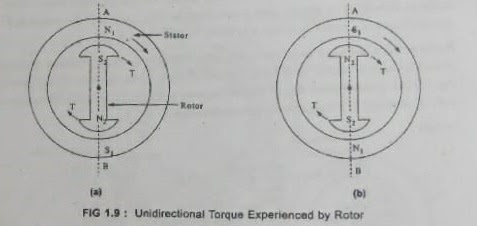PROCEDURE to START a SYNCHRONOUS MOTOR
Suppose the rotor is rotated by some external means at a speed very near or equal to
synchronous speed. And then the rotor is excited to produce its poles.
At a certain Instant now, the stator and rotor unlike poles will face each other such that
their magnetic axes are near each other. Then the force of attraction between the two
pulls both of them into the magnetic locking condition.
Once magnetic locking is established, the rotor continuously experiences a unidirectional
torque in the direction of the rotating magnetic field (r.m.f. Hence rotor rotates at
synchronous speed and said to be in synchronism with r.m.f.
4 Then the external device used to rotate the rotor can be removed. But rotor will
continuous to rotate at synchronous speed due to magnetic locking.
This is the reason why synchronous motor runs only at synchronous speed. This
operation is shown in the Fig. 1.9.
